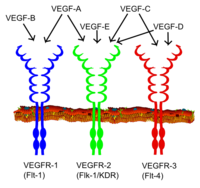
Photo from wikipedia
Major depressive disorder is a chronic psychiatric disease with a high prevalence. Brain mechanisms for depression at cellular and molecular levels are far from clear. Increasing evidence from clinical and… Click to show full abstract
Major depressive disorder is a chronic psychiatric disease with a high prevalence. Brain mechanisms for depression at cellular and molecular levels are far from clear. Increasing evidence from clinical and preclinical studies reveals critical roles of the non-receptor tyrosine kinase (nRTK) superfamily in the pathophysiology, symptomatology, and therapy of depression. To date, several nRTK members from three nRTK subfamilies, i.e., the Src family kinase (SFK), the Janus tyrosine kinase (JAK) and the focal adhesion kinase (FAK) subfamilies, may connect to the intracellular, intranuclear, and synaptic signaling network linking chronic stress to depressi- and anxiety-like behavior. These SFK/JAK/FAK nRTKs are abundantly expressed in the prefrontal cortex and hippocampus, two core limbic regions implicated in depression, and are enriched at synaptic sites. In various acute or chronic animal models of depression, the nRTKs were significantly altered (up- or downregulated) in their phosphorylation, expression, subcellular/subsynaptic distribution, and/or function. Stress that precipitates depressive behavior also influenced the interaction of nRTKs with other signaling molecules and downstream substrates, including ionotropic and metabotropic glutamate receptors. The commonly-used antidepressants showed the ability to alter nRTK activity. In sum, the limbic SFK/JAK/FAK nRTKs are sensitive to stress and undergo drastic adaptations in response to chronic depression. These long-lasting adaptations contribute to the remodeling of signaling network or synaptic plasticity critical for the vulnerability to depression and the therapeutic efficacy of antidepressants.
Journal Title: Journal of integrative neuroscience
Year Published: 2022
Link to full text (if available)
Share on Social Media: Sign Up to like & get
recommendations!